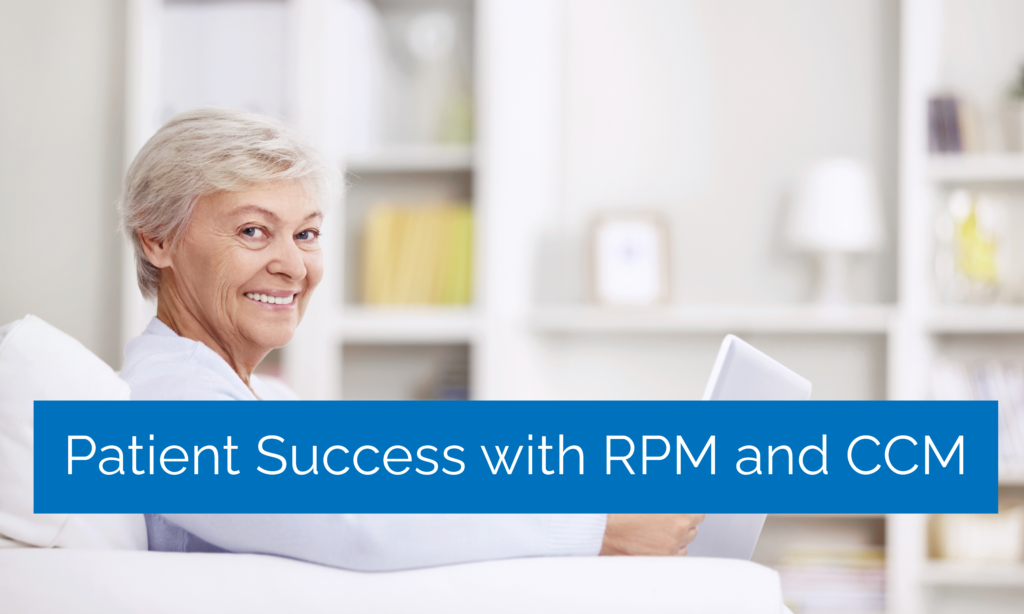Virtual healthcare services like Remote Patient Monitoring (RPM) and Chronic Care Management (CCM) have been at the forefront of patients successfully managing their chronic conditions and leading healthier, happier lives. The Center for Medicare and Medicaid Services (CMS) has been promoting RPM and CCM programs for years to achieve value-based care because they have been effective in producing positive health outcomes and reducing healthcare costs for all stakeholders.
So how is patient success measured? How do RPM and CCM ensure it?
Patient success occurs when a patient can meet their defined healthcare goals. With the provider’s effective care, the patient has regained control of his condition and avoided episodes of further escalation. To put it simply, the patient is pain-free and enjoys a higher quality of life despite contending with chronic illnesses..
Patient engagement that personalizes the patient experience
Patient success with RPM and CCM relies on the following conditions:
RPM and CCM have had a positive impact on patient engagement. Patients are asked and then educated to actively participate in these programs by taking their own measurements with data automatically transmitted using cellular technology. With a few simple actions, patients instantly get updated on their progress and know where they are in meeting set goals that are part of their care instructions. These actions give them positive encouragement and let them know their status is being monitored.
Meanwhile, care coaches keep them engaged through care calls every month. The care coaches call the patients to review their progress and make the necessary adjustments in the trajectory of care. Most elderly and isolated CCM enrolled patients welcome these care calls especially when the care coaches have over time been effective in establishing meaningful relationships with their patients. This kind of personalized support is exactly what patients crave. With this extra layer of care, patients will become more open and honest when it comes to their symptoms. The care coaches can also easily pick up on even the subtlest of changes that could indicate a change in overall conditions. This escalation can also be easily prevented with the appropriate intervention.
Clinical interventions that focus on “wellness” not just “sick” care
Within value-based care models, RPM and CCM offer continuous care that does not merely focus on a singular episode that requires urgent attention just like how traditional care is delivered. Though CCM with RPM is designed to be attentive to sick patients with chronic conditions or in post-acute care, the overarching goal is to treat the whole person while they are feeling well and not when they are already very sick or in pain.
Value-based care takes into account the patient’s overall wellness, which is why care coaches are also trained to look for signs and symptoms of depression. This is especially true with elderly patients, many of whom suffer from loneliness and isolation that could negatively impact their health. With CCM, the regular calls from their care coaches provide them with the interaction and socialization they need and look forward to.
RPM and CCM are also preventative care models. Take, for instance, a patient recently discharged from the hospital who begins to show early symptoms and signs of congestive heart failure disease. His next appointment is due in two weeks. Within this period, anything can happen that could lead to a medical crisis like having difficulty breathing or severe chest pains. This could mean a trip to the ER or hospitalization for the patient, adding more burden to an already overwhelmed healthcare system. With RPM, the patient’s weight and pulse oximetry are easily captured so that the appropriate action can be given by the clinician. With CCM, the care coaches can check on correct sleeping positions that will not place a further strain on the patient’s sleep health. All these touchpoints prevent the patient’s readmission.
Synchronized care that makes sense
RPM and CCM take care of the crucial time in-between office visits or post-hospitalization such as in the example above. RPM captures real-time data for clinicians to ascertain a patient’s health status. CCM provides multiple touchpoints to ensure compliance to care plans, adherence to medications, and coordinated care with other specialists. Together, RPM and CCM synchronize care, which is why CMS allows its “stacking” to give providers additional billable services for their non-face-to-face care.
RPM and CCM are value-based healthcare solutions that elevate the quality of care, increase access and enhance the patient experience. Their contribution to the healthcare industry is invaluable, particularly in managing the high-risk and high-cost patient population. Hence, CMS promotes RPM and CCM by enticing primary care providers with more incentives through a variety of reimbursements that can mean free cash flow directly to the bottom line.
With the adoption of these telehealth solutions seemingly inevitable, practices are faced with the challenge of building their own virtual care programs. However, there are many variables to contend with like cost, personnel, equipment, software, and capabilities. A good number of practices have ventured to start their own RPM and CCM programs but found themselves unable to scale up or, at least, have a positive ROI.
If you are a primary care practice interested in leveraging the benefits of RPM and CCM without the huge cost and possible disruption to your practice routines, Ascent Care Partners (ACP) offer turnkey virtual care solutions. ACP offers a strategic partnership and full services from patient enrollment to the preparation of billing charges. You will optimize and innovate your delivery of care, but you will also tap a new revenue stream to keep your practice independent and avoid increasing overhead.
Together CCM and RPM synchronize care that is anchored on prevention. Truly, now is the best time to engage with ACP to experience proven patient successes with RPM and CCM.



